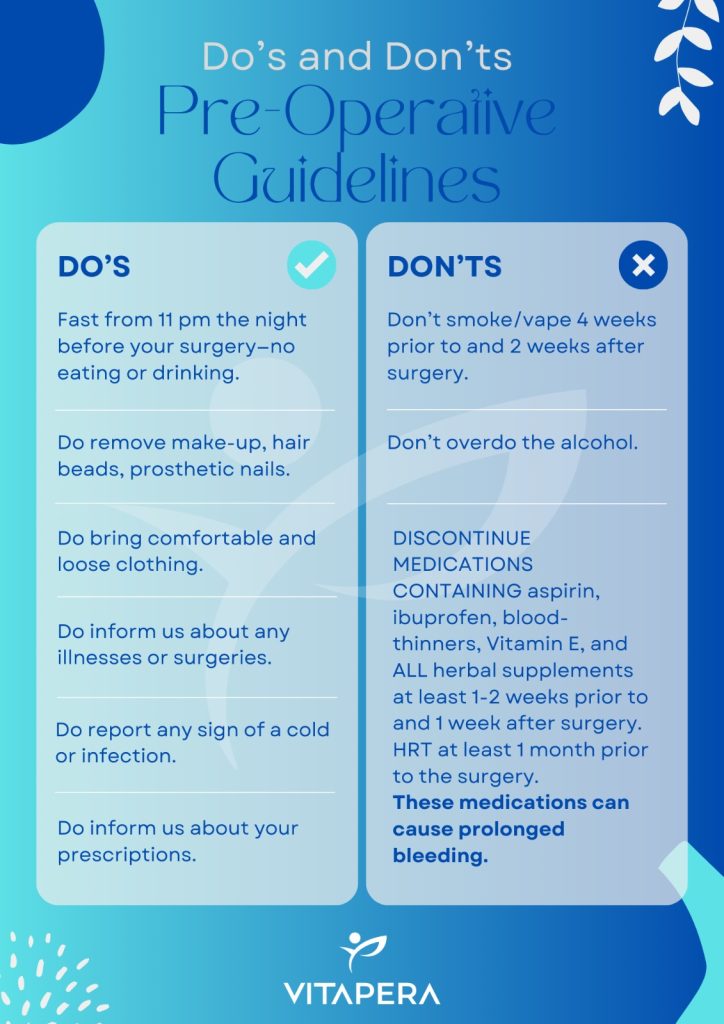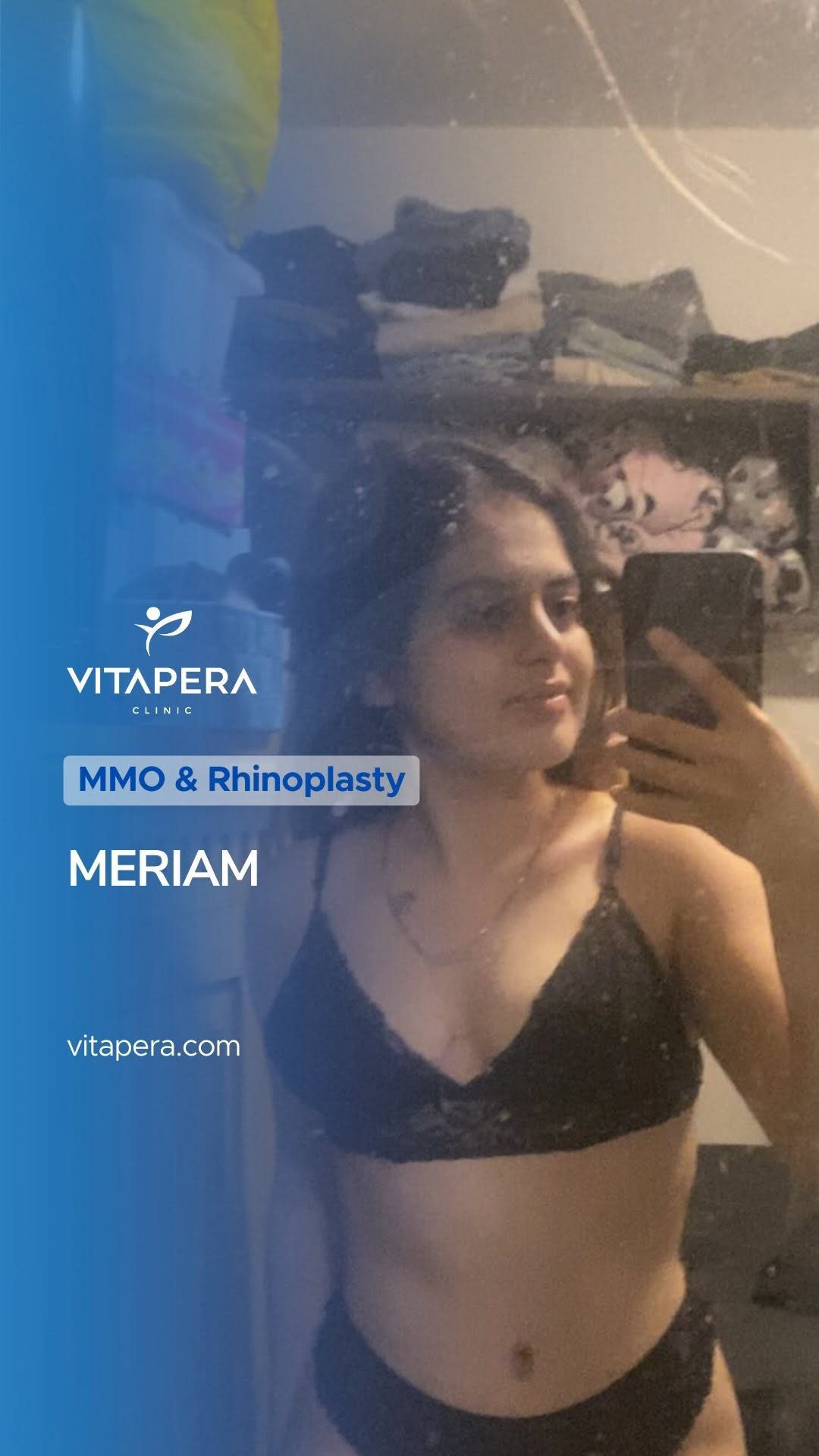Recovering from cosmetic surgery takes patience and planning, but knowing what to expect can help you return to normal life smoothly. In the first days after any procedure, you’ll likely feel groggy from anesthesia with swelling, bruising, and discomfort. You should arrange to have a responsible adult with you for at least the first 24–48 hours – you won’t be able to drive yourself home and will need help with basic tasks.
Doctors encourage gentle movement as soon as possible, such as short walks around the house, to promote circulation and prevent blood clots. Rest often, keep your head elevated (for facial procedures like rhinoplasty), and follow all wound-care instructions. Expect to use prescribed pain medication during this time. It’s normal to feel tired and sore; focus on recuperation and lean on friends and family for support.
Immediate Post-Operative Recovery
First 24–48 hours:
You will likely be drowsy and should avoid any strenuous activity. Vitals and pain will be monitored in recovery, and you’ll receive specific instructions before you leave. Arrange a ride home ahead of time and have a helper ready to assist. Most patients walk around a little on the same day or the next day to improve circulation. Plan to eat light meals and stay hydrated, which aids healing. You may also have surgical drains or bandages – follow your surgeon’s guidance on how to manage these.
Expect swelling and bruising to peak in the first 2–3 days; applying cold compresses (ice packs wrapped in cloth) to the area for the first 72 hours can reduce swelling and discomfort. For example, after rhinoplasty (nose surgery), swelling and bruising around the nose and eyes are common and usually significantly improve within 1–2 weeks.
Physical limitations:
Immediately after surgery you will have restrictions for safety. Do not lift heavy objects (generally nothing over 5–10 pounds) or do anything that strains your incisions. For body-contouring surgeries like a tummy tuck or “Mommy Makeover”, you may have internal stitches that require you to walk with a slight bend at the waist to avoid stressing your belly muscles.
If you had a Brazilian Butt Lift (BBL), you should avoid sitting directly on your buttocks for about 2–4 weeks. Use pillows or special “donut” cushions under your thighs whenever sitting (even in a car) to keep pressure off the newly grafted fat. During this time, sleep on your stomach or side, not on your back, to protect surgical areas.
Driving and commuting:
You should not drive while taking narcotic pain medications or if you feel weak. In general, many patients resume driving about 5–7 days post-op (when they can comfortably react and wear a seatbelt). However, more extensive procedures have longer restrictions. For instance, Mommy Makeover patients (often having a tummy tuck and breast surgery together) are usually cleared to drive only after 2–4 weeks, once off narcotics and able to buckle up without discomfort. After a BBL, surgeons typically advise avoiding driving for at least 2–3 weeks to prevent pressure on the buttocks. Always follow your surgeon’s advice: do not rush back behind the wheel until you feel safe and pain-free.
Resuming work and normal activities:
Light desk work can often be resumed within 1–2 weeks after less extensive procedures, provided you feel up to it. Non-physical jobs generally don’t require the same healing as heavy labor. Many mommy makeover patients return to a desk job after about 2–3 weeks of rest. Use this time to focus on recovery: arrange childcare and household help as needed, and work from home if possible. Avoid stressful situations and give yourself permission to take it easy during this period.
Walking, Sitting, and Moving
Early movement: As soon as you’re able, get up and walk for a few minutes every hour. Light walking is strongly encouraged by doctors because it improves blood flow, reduces swelling, and lowers the risk of complications like blood clots. Start with very short distances (just around your bed or home) even on day 1 post-op. Increase your walking distance day by day as you feel comfortable. Avoid prolonged bedrest or sitting for the first few days, except when resting.
Sitting and posture: How you sit or lie down depends on the procedure:
- Abdominal surgeries (tummy tuck, Mommy Makeover) – Keep your upper body slightly reclined (propped on pillows) and bend at the waist when sitting to avoid pressure on the incision. You may naturally walk with knees bent early on to protect your abdomen. Sleep with pillows under your knees or a recliner chair to take tension off the incision and make breathing easier.
- Breast surgery (augmentation/lift/reduction) – You will likely have an elastic surgical bra or bandage. Wear this as directed; it helps reduce swelling and supports your breasts. You may need to adjust a seatbelt or use padding so it doesn’t press uncomfortably on the chest.
- BBL and butt lifts – Use a special pillow (or rolled towel) under your thighs as described above. This lets you sit without putting direct weight on your buttocks. Even in a car, you can sit by placing the cushion on the front edge of the seat and leaning back so that only your thighs touch the pillow. After about 2–3 weeks, you can slowly resume brief periods of sitting as long as you continue to protect the area.
- Facial surgeries (rhinoplasty, facelifts) – Keep your head elevated on pillows for the first week or two to reduce facial swelling. Avoid lying flat or on your stomach. Sleep with your head propped up about 30–45° for about 6 weeks to prevent extra bruising or swelling.
Lymphatic exercises: Gentle ankle pumps, wiggles, and short walks help your body clear lymphatic fluid. Elevate surgical areas when resting (e.g. prop your legs or head on pillows) to reduce swelling. For lower-body surgeries, lie down flat periodically so fluid doesn’t pool in one place.
Managing Swelling, Bruising, and Pain
Proper post-op care greatly eases discomfort and speeds healing. Follow these guidelines:
- Compression garments:
Wear any prescribed compression wear (binders, bras, leggings, etc.) exactly as instructed, often 24/7 for 2–6 weeks. These garments minimize swelling and help the skin shrink to your new contours. For liposuction, surgeons typically recommend continuous wear for at least 2–4 weeks. For abdominoplasty or Mommy Makeover, abdominal binders are common. The pressure from compression garments helps reduce fluid build-up and supports healing.
- Pain medications:
Take medications on schedule in the first few days. This not only keeps pain under control but also allows you to move more comfortably. Many clinics advise staying on pain meds for about a week, then tapering off. Do not drive or operate machinery while on narcotics.
- Cold therapy:
Use ice packs (wrapped to avoid skin contact) on swelling-prone areas for the first 48–72 hours. For example, doctors recommend cold compresses on the cheeks (not directly on the nose) for the first 3 days after rhinoplasty to reduce swelling and bruising. Do 15–20 minutes on, 15–20 off.
- Elevation:
Keep the operated area elevated relative to your heart whenever possible. Elevate your legs after leg/thigh surgery, raise your head for facial or breast surgery, and rest on pillows. This cuts down swelling.
- Nutrition and hydration:
Eat a balanced, high-protein diet rich in vitamins C and A to support tissue repair. Stay very well hydrated (water and electrolyte drinks) to help your body heal and flush anesthesia out. Avoid excess salt or alcohol, which can increase swelling. A healthy diet also means plenty of fruits, vegetables, lean protein (chicken, fish, beans), and whole grains. Fatty, fried foods and sugars should be limited in the first weeks.
- Avoid heat and salt:
Hot baths, saunas, and salted foods can worsen swelling. Stick to lukewarm showers and a low-sodium diet initially.
- Scar care:
Scars are a normal part of surgery. Once incisions have closed (usually by 1–2 weeks), you can begin gentle scar management. Your surgeon may recommend silicone gel sheets or scar creams to apply daily; these help flatten and fade scars over months. Keep scars clean and protected from sun (use SPF 30+ once healed) to prevent darkening. At about 6 weeks, once incision edges are strong, you can also start gentle circular massage on scars (with a safe moisturizer) to improve blood flow and flexibility.
- Avoid smoking and alcohol:
Tobacco smoke significantly impairs healing by reducing blood flow. Doctors universally advise stopping smoking (and avoiding second-hand smoke) for at least one month before and after surgery. Likewise, limit alcohol, especially while on pain meds. Healing requires oxygenated blood and nutrients – smoking, alcohol, and steroids inhibit that.
Expect discomfort for about 1–2 weeks in most cases, which gradually improves. It’s common to have redness or tenderness around incisions; hot flashes of pain should subside with rest and treatment. If swelling or bruising is severe in any one area or if you have disproportionate pain, contact your doctor. But in general, bruises turn from purple to yellowish over 1–2 weeks and then fade.
Returning to Exercise and the Gym
Exercise is an important part of long-term health, but timing is critical:
Light exercise:
You can start very gentle activity (e.g. walking, stationary cycling, bodyweight stretches) usually around 4–6 weeks post-op, once cleared by your surgeon. For example, liposuction and BBL patients are often encouraged to begin “booty-friendly” walks at 4–6 weeks. After rhinoplasty, light cardio (like brisk walking) can often resume at 3–4 weeks. At about one month, many patients can reintroduce non-strenuous workouts, as long as each movement doesn’t pull on incision sites.
Strenuous exercise:
Most surgeons recommend waiting about 6 weeks before returning to any heavy workouts, weightlifting, or high-impact sports. For instance, by 6 weeks the nasal bones are considered stable and patients can resume resistance training after rhinoplasty. Similarly, after a tummy tuck or Mommy Makeover you can slowly add in weight-bearing activities after 6 weeks, but even then avoid sudden twists or heavy lifts.
Procedure-specific notes:
Mommy Makeover: This combines surgeries like tummy tuck, breast lift/augmentation, and sometimes liposuction. Because the tummy tuck is usually the most extensive, women typically wait about 4–6 weeks before full activity. Gentle walking and light arm movements are okay early, but no heavy lifting (including kids) for at least 6 weeks.
Liposuction: Moderate exercise (walking, light cardio) can begin a few days to 1 week after lipo. Full gym routines usually resume around 6 weeks. Wearing your compression garment to the gym as directed will help.
BBL: Since you must avoid sitting on your butt initially, glute-target exercises (squats, lunges) are delayed. Most surgeons advise no lower-body resistance training for about 6–8 weeks. Light movements like lying-leg raises or gentle incline walking may start around week 4–6 under supervision. Always stand or move every hour to improve circulation.
Rhinoplasty: Aerobic exercise (jogging, elliptical) can often resume around 3–4 weeks. Avoid any activity that increases heart rate above resting in the first month. Heavy lifting and jarring movements (like running or aggressive yoga) should wait until at least 6 weeks, after swelling is mostly gone and bones have healed.
Slowly increase intensity and always listen to your body. If you experience unusual pain, increased swelling, or dizziness, stop and rest. Your doctor will give the final “go-ahead,” so keep all follow-up appointments before clearing your gym routine.
Resuming Travel (for Medical Tourists)
If you traveled abroad for surgery, planning your trip home is critical. Clinics that serve international patients (like Vitapera in Turkey) often provide comprehensive support – arranging airport pickup, translators, and accommodations. Before booking flights home, consult your surgeon.
Many plastic surgeons recommend waiting at least 2–4 weeks before flying, especially after major procedures like tummy tucks or BBLs. The cabin’s low humidity and pressure changes can worsen swelling or fatigue, and sitting in one position for hours can risk clots. For example, experts advise a minimum of 2 weeks before flying after a Brazilian Butt Lift, and up to 4 weeks for long-haul international flights. Always get clearance from your surgeon on your individual recovery before booking travel.
When you do travel, take precautions: choose an aisle seat to easily stand up and stretch every 30–60 minutes. Bring pillows or inflatable cushions to pad pressure points (especially important after BBL or liposuction). Wear loose, comfortable clothing and any recommended support garments under your clothes. Continue to stay well-hydrated, walk up and down the aisle periodically (when safe), and do gentle ankle rotations in your seat to boost circulation. Pack your prescription medications and a first-aid kit or any dressing supplies you need, just in case. Keep your clinic’s contact info on hand, and consider scheduling a video or in-person follow-up during or after travel.
In summary, don’t rush home. Give yourself the extra days (or weeks) to heal in the surgeon’s care before flying, and plan for some assistance upon returning. As one Vitapera guide notes, clinics may arrange local tours or transport, but “doctors will not advise touring activities directly after the procedure”. Patience in the recovery phase leads to safer travel and better results.
When planning post-surgery travel, remember: no trips until you’re cleared. For example, after a BBL most doctors suggest waiting 2–4 weeks to fly, and always use pillows and compression on flights to protect your recovery.
Emotional and Psychological Recovery
Cosmetic surgery can bring an emotional roller-coaster. It’s common to feel a mix of excitement and anxiety after surgery. The initial appearance (bruising, swelling, bandages) may not look like your final results, which can be startling. Patience is key: full healing can take months, and “you will heal… it just takes time,” as a rhinoplasty expert reminds patients. Rest assured that most bruising and numbness gradually fade; for instance, bruising is usually gone by 2 weeks after a nose job.
Ask for support. Vitapera advises building a network of friends or family who understand what you’re going through. Let people help – whether that means having a loved one prepare meals, care for children, or just sit with you. Feeling fretful or down during recovery is normal; caring for your emotional health is as important as your physical care. Many patients find that sharing their journey with others (even online patient groups) eases anxiety and provides encouragement.
If English isn’t your first language, remember that clinics often provide translators during your stay, so you can express concerns without a language barrier. Also, know that having a companion is typically allowed (Vitapera allows one guest without extra charge). Bringing a friend or family member can be comforting and helpful for managing logistics.
Try simple self-care: gentle walks in nature, listening to music, or reading can keep spirits up. Maintain a healthy diet and sleep schedule to prevent mood dips. And celebrate small milestones – like changing your first bandage or seeing your first bruise fade. Recoveries thrive on a positive, supportive environment: as one surgeon notes, healing “flourishes in a teamwork where wellness is nurtured”. Be patient with yourself; the emotional adjustment is part of the journey to feeling good about your new appearance.

Long-Term Lifestyle Habits for Best Results
Your efforts after recovery will shape your lasting outcome. Experts emphasize that maintaining cosmetic results requires ongoing commitment to healthy habits. View surgery as a jump-start: now is the time to solidify or adopt a lifestyle that supports wellness.
- Balanced diet: Continue eating protein-rich foods (chicken, fish, legumes) to support tissue health, plenty of fruits and vegetables for vitamins (Vitamin C, A, etc.), and whole grains. This provides the nutrients needed for final healing and collagen formation. Avoid crash diets or yo-yo weight changes, as even losing or gaining a few pounds can alter surgical outcomes.
- Regular exercise: Stick with the exercise plan your surgeon approved. Long-term fitness keeps weight steady and muscle tone improved, helping maintain your new shape. Most patients see years of improvement if they keep active – gentle activity like yoga, walking, or gym workouts all contribute to lasting results.
- Hydration and self-care: Drinking plenty of water and limiting alcohol helps your skin and body stay supple. Daily self-care routines (like dedicated relaxation time or gentle stretching) keep stress low, which can otherwise cause weight gain or poor skin health.
- Scar and skin care: Protect your scars and skin from sun. Scarring can darken if exposed to UV light, so apply SPF 30+ on scars for at least 6–12 months. Continue silicone gel sheets or scar creams as advised. Over time, massage scars gently to keep them soft.
- Avoid smoking: Even after you’ve finished healing, smoking is strongly discouraged. The reason is the same: it limits blood flow and damages collagen. Staying smoke-free supports the longevity of your results.
- Follow-up visits: Keep all post-op appointments. Your surgeon will monitor healing at key milestones (often 1 week, 1 month, 3 months, 6 months, etc.) and can advise if any additional touch-ups (like minor scar revisions or fat grafting) are needed.
- Realistic mindset: Remember that some minor swelling can last 6 months or longer. As Dr. Paco Canales notes, mommy makeover swelling gradually subsides over months and final results often appear around 6 months. Rhinoplasty patients may wait up to a year to see the final refined shape. Be patient and continue your healthy routines; the changes will become evident bit by bit.
Embracing a healthy lifestyle after surgery is crucial. Experts agree that maintaining a balanced diet, regular exercise, and hydration is the best way to preserve your surgical results. For example, many surgeons note that avoiding weight fluctuations and staying active help your new contours last for years.
In summary, returning to your daily routine after cosmetic surgery is a gradual process. Follow your surgeon’s guidelines closely, listen to your body, and give yourself time to heal. With proper care—physical rest, wound management, and healthy habits—you’ll support a smooth recovery and help ensure that the stunning results you envisioned become a lasting reality.










